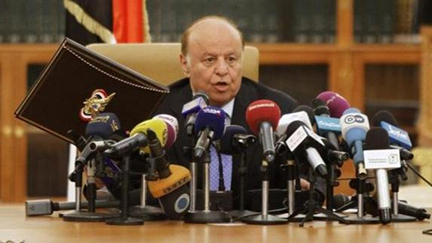
President Hadi, who is currently governing from Aden
Yemen’s legitimacy crisis is not new but is critical
By: Sama’a al-Hamdani, al-Araby al-Jadid, 3 March, 2015
On February 21, Yemen’s President Abd-Rabbo Mansour Hadi, escaped the Houthi-mandated house arrest and successfully fled to the southern city of Aden. A few hours later, al-Jazeera television broadcast a statement by the then resigned president. At the end of the statement, Hadi signed his name, “Abd-Rabbo Mansour Hadi, President of the Republic of Yemenâ€. It strongly suggested he had withdrawn his resignation.
So Yemen is now left arguably with two former presidents (Hadi and Ali Abdullah Saleh), a hugely powerful rebel militia leader (Abdulmalik al-Houthi), several secessionist movements (a couple of Southern Hiraks, a Marib Hirak and a Tihaman Hirak), UN-backed transitional committees, and two transitional agreements (The Gulf-Cooperation Council (GCC) transitional deal of 2011 and The Peace and Partnership Agreement of 2014).
In this confusion what, or rather, who, has legitimacy?
The question of legitimacy has become a focal point of Yemeni politics even though the country suffered from a legitimacy crisis long ago. Many argue legitimacy in favor of Hadi derived from the GCC agreement and other legal mandates. However, political legitimacy, as per philosopher John Locke, is not about legality but rather derives from “the consent of those who are governedâ€. Legitimacy is about who is recognized and accepted by the people as “right†or “proper†to rule. With several key players on the ground, Hadi may be the legal ruler of Yemen but it does not necessarily mean he is the legitimate one.
A decades-old problem
There are several modes of political legitimacy and arguably Yemen has suffered from a legitimacy crisis since 1962 in the North and 1967 in the South. Those newly formed independent states failed to continue traditional modes of governance whether these were imamates, sultanates, or distorted forms of tribalism. Saleh ruled the north of Yemen and then a united Yemen for 33 years under the pretext of democracy and constitutional legitimacy. In reality, Saleh’s sphere of influence was always city-centric and his mode of governance was a unique concoction of autocracy, theocracy, tribalism and oligarchy.
Saleh’s charismatic ability as a leader granted him elite-centered legitimacy. With him out of power in 2011, the system he devised struggled. A transition mediated by the GCC elevated Saleh’s deputy, Hadi, as Yemen’s new president subsequent to a one-man election. The newly formed National Unity Government, containing ministers from different political parties, was given an opportunity to gain public trust and to establish rule of law.
Meanwhile, the international community alongside the country’s elites devised a transitional plan to be executed over two years. The country held a National Dialogue Conference (NDC), from March 2013 to January 2014, in hopes of drafting a new constitution and establishing civil authority. Meanwhile, the government was meant to continue its functions under the scrutiny of the parliament, the Supreme National Authority for Combating Corruption (SNACC), the Court of Public Funds, and the Central Organization for Control and Auditing (COCA). In theory, it seemed foolproof.
The reality was that the NDC derived its authority from a pool of new post-revolution-elites and from external powers, i.e. the international community. In practice, the NDC was sheltered and Hadi’s government struggled to provide basic services to the public. His reign witnessed the collapse of several public institutions, including the military and justice system. Moreover, the checks-and-balances put in place failed to function. The parliament, elected in 2003, was no longer legal nor legitimate, and SNACC’s latest appointments were ruled unconstitutional for failing to meet the basic criteria of appointments. Bodies, like COCA, didn’t work for the people but benefitted instead the individuals responsible for appointing their boards.
Transitional decay
Taking advantage of the government’s decay, Houthi rebels took over the capital Sanaa in September 2014 and within days, they signed a Peace and Partnership Agreement with Hadi and members of opposition parties. In January, the month-old government and Hadi resigned, only to be kept under house arrest. Meanwhile, the Houthis, who originally derived their legitimacy from spiritual authority – from being Aal-al-Bayt, “people of the house†or members of the family of the Prophet Muhammad – decide to speak in the name of the Yemeni people, claiming their legitimacy is “revolutionary†now.
But Yemenis do not believe the Houthis (or Hadi’s government) have the “right to rule†all of Yemen. Indeed, the political elites have lost touch with the people. At their weakest, they rarely speak of elections and are quick to rush into settlements that function merely as a palliative to Yemen’s legitimacy problems.
Since 2011, the weak performance of the government forced Yemenis to search for other modes of protection. Disengagement between the ruling elites and those who are ruled resulted in the proliferation of micro-identities, a return to unconventional tribalism, and a pursuit of other forms of governance; each movement deriving its legitimacy from local adherents. There is a general sense of disintegration and the ground is fertile for conflict.
Political alliances working towards the creation of a pluralistic civil state is the only path towards peace and good governance. Holding fair transparent elections is necessary in order to move forward in hopes of creating a relationship between the rulers and those who are ruled. The answer is to give power to the people. Only then can they give legitimacy to their rulers.